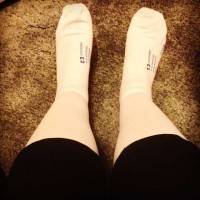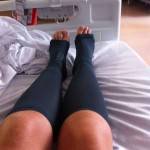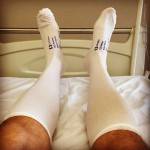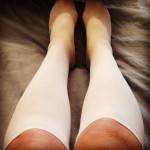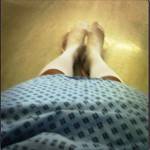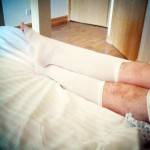Surgical compression stockings
Compression Socks before surgery?
I highly suggest that you seek a second opinion. Abdominoplasty surgery is not to be taken lightly, and your surgeon needs to make sure your health is of his upmost concern.
I like to say, When in doubt, don’t! Abdominoplasty is a very safe procedure in the right hands.
Consult with a Board Certified Plastic Surgeon to discuss these concerns. (Robert E. Zaworski, MD, Atlanta Plastic Surgeon)
Compression Stockings vs SCD in Breast Reduction
Your plastic surgeon should assess your risk using the Caprini Scale. You can find this at PreventDVT.org and click on”Assess your DVT Risk” on the right side and then click “download a PDF of this Risk Assessor” in the center text. Without knowing your risk factors, it is hard to say what you need but almost all surgeons use SCDs at a minimum. If fact, a tummy tuck combined with a breast reduction may be a high risk combination and I would very strongly recommend SCDs being used.
The compression stockings have not been shown to make a significant change in reducing DVTs or PEs and so are not needed. Make sure you get out of bed as soon as you can after surgery and walk as much as possible (with approval of your surgeon). The American Society of Plastic Surgeons published their DVT prevention recommendations this year. (Karol A. Gutowski, MD, FACS, Chicago Plastic Surgeon)
As others have expressed here, SCD use during abdominoplasty surgery is appropriate for preventing DVT. Compression stockings alone are not the standard of care in most communities. If you have other risk factors, additional measures, such as blood thinners, may be indicated. (Michael S. Hopkins, MD, Albuquerque Plastic Surgeon)
Deep Venous Thrombosis prevention
All patients should be assessed for their risk of deep venous thrombosis and pulmonary emboli. The Caprini assessment risk factors. Considering the magnitude of your surgery and other factores compression stocking are not enough. sequential compression stocking is a must for all patients undergoing surgery under general anesthesia. If they score high in the caprini score they may also require blood thinners starting the day after surgery.
You should be given a post operative instructions and symptoms of deep venous thrombosis and pulmonary emboli and what to do if any of the symptoms occur. If your surgery is done in a hospital, the hospital will have a requirement for such assessment.
If your surgery is done in a surgicenter or office based surgery facility they should have an SCD. This is required id the facility is accredited. If the facility is not accredited then you should look for another surgeon. (Samir Shureih, MD, Baltimore Plastic Surgeon)
Compression socks will not be sufficient. Your risk should be assessed by using the caprini scale. This allows to give a more detailed assessment of somebodies risk of developing dvt. (Bianca Knoll, MD, West Orange Plastic Surgeon)
I would feel more comfortable with this size of surgery to have the compression devices. Maybe you can insist t on wearing them to prevent a dvt complication . Not very expensive (Sanjay Lalla, MD, FACS, Las Vegas Plastic Surgeon)
Both protocols attempt to decrease the chance of clots forming in your legs and possibly traveling elsewhere in your body causing problems. Every surgeon is different. Most respondents on this board note that they would use the SCD device at time of surgery. I think this is appropriate as well. Please talk to your surgeon about this. See what his/her rationale is. (Jeffrey Roth, MD, Las Vegas Plastic Surgeon)
Precautions to take to prevent DVT
You are accurate in your concern regarding DVT prevention. Surgery is a well-documented risk factor in forming blood clots. For all of my patients, I routinely use both TED compression hose and SCD. I also encourage early ambulation as an added pre caution against blood clots. There is really no reason to do less. Review your concerns with your chosen physician. (George John Alexander, MD, FACS, Los Angeles Plastic Surgeon)
- graduated compression stocking
- graded compression stockings
- compression stockings
- compression stockings surgery
- compression stockings for women
- compression stockings for nurses
- compression stockings for men
- compression stockings after surgery
- compression stocking
- best compression stockings
- compression stocking aid
- medi compression stockings
Sequential Compression Devices should be used in all tummy tuck patients, and if your Caprini risk assessment puts you in a higher risk category you should receive chemoprophylaxis (Lovenox, etc.) as well. (Kenneth B. Hughes, MD)
Most of us feel that just using compression socks alone is probably not enough, especially for a tummy tuck and breast lift. SCD’s along with medication is probably the standard of care in most cases now and while we all like to look at our track record and it’s success, new guidelines are being developed in medicine all the time and should not be ignored. (John J. Corey, MD, Phoenix Plastic Surgeon)


